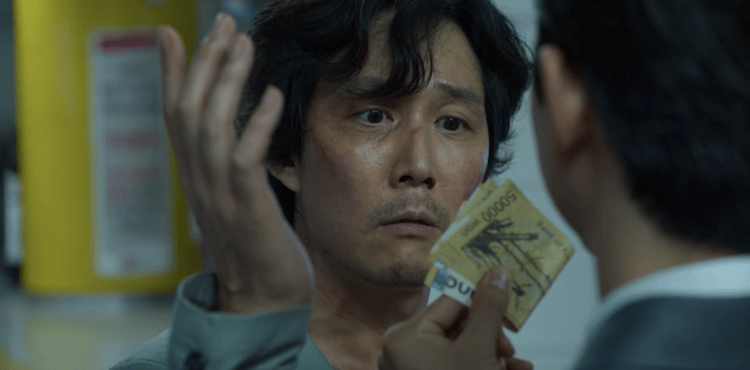
“Squid Game” is a Korean survival-game show where contestants compete against each other by playing childhood games. “Red Light, Green Light,” for example, is the first one played in the show. The catch? If you get caught running after you’re supposed to stop, you die. I described the show to a friend as “The Hunger Games,” but with a twist. The story follows participants who have found themselves drowning in debt from life’s unfortunate circumstances and have been recruited to play these games in order to win a hefty grand prize of ₩45.6 billion — roughly $40 million dollars.
The main character is Seong Gi-Hun, player 456, who enters the game in debt from his gambling addiction with no way to financially support his daughter. He was recruited while waiting for the train when an unknown man asked him to play a seemingly simple game. The man offers Gi-Hun money if he wins, but if he loses he gets slapped instead. The game is called “ddakji” in Korean, and the goal is to throw an origami-style paper figure on top of another in order to flip it over. After receiving multiple slaps from the man at the train station, Gi-hun finally wins a round and wins the cash prize, but also a business card with a cellphone number which he eventually calls to join the game.
The show portrays that being good is not always enough to succeed, as the games require the participants to show their true selves in order to have a chance at winning. For example, Gi-Hun is playing alongside his childhood friend, Sang-Woo, who’s participating in order to offset his financial burdens, including his mom’s food market, which he secretly sold as collateral. Seeing the cash prize looming over his head turns him into the true fiend that he really is. You see this unfold while watching Episode Six. While the participants blame the situation they were put in for the consequences they have to face during their trial, they are reminded that they chose to return after being released by whoever is in charge of the games they’re participating in. After all, they had nothing to lose, but they had something to gain — a second chance in life.

Based on a manga of the same title, the original “Alice in Borderland” was first serialized in an illustrated magazine in 2010 and was made into a live-action by Netflix only last year. The story follows Arisu, a gamer who believes he does not fit in with his family, and two of his friends. While having fun in Tokyo, they cause an altercation and the police go after them. After emerging from their hiding place in a bathroom stall, they find the usually busy streets of Shibuya empty. A series of events lead them to a “gaming area” — a building with a stack of smartphones inside. The trio is thrown into a world without an exit where they have to play games to ensure their survival.
Similar to “Squid Game,” if you lose the games in “Alice in Borderland,” you die. Leaning towards the genres of sci-fi and thriller, the beginning of the season starts out as a slow burner for character development. The third episode is where the heat begins. It comes out of nowhere and compels you to continue watching. Differently from “Squid Game,” the Japanese show’s games are more strategic, requiring some brain-work and agility to solve the quests they are put into.
Within a month since its release on September 27, “Squid Game” has become the most-streamed Netflix show as of October 13th, surpassing “Bridgerton” by 28 million views. The Korean dystopian show broke barriers, from starting out as an unknown series to topping the charts in ninety countries. It is strange to think that its creator, Hwang Dong-hyuk, had been rejected to produce the now-successful show for over a decade until it was picked up by Netflix. Apparently, the idea of utilizing childhood games was not appealing enough, especially because the once-innocent playground would become a graveyard.
This increase in popularity of Korean dramas has been happening for a few years. We have BTS and Blackpink dominating the music scene here in the United States, as well as having the acclaimed films “Parasite” and “Minari” opening doors for the Korean entertainment industry outside of their country. K-dramas are known for their high-quality production and phenomenal acting that helps the audience connect with the characters. They also are inclined to be more PG compared to Western productions, amplifying the range of audiences reached. At the same time, they explore societal issues — for instance, “Squid Game” and “Parasite” are commentaries on the ills of capitalism — that are universal and relatable to different viewers.
All of these combined created a K-wave in today’s media, and it seems like this phenomenon is only growing. The popularity of “Squid Game” came from memeable scenes and catchy tunes that were reproduced on TikTok, awakening people’s curiosity about the show. You might remember mukbang similarly becoming a global phenomenon on YouTube almost a decade ago, as well as an increase in Korean food popularity due to online content.
Koreans believe that the rise of popularity over their dramas has to do with a variety of themes in their shows, a common pattern in Western entertainment. Netflix alone invested $500 million dollars this year in Korean content.
Japanese dramas, on the other hand, are not on the same level as their neighbors’. Besides having great production and amazing casts, Japanese entertainment is still stereotyped by its other popular mediums — anime and manga — and is often overshadowed by well-produced Korean shows.
From my own experience living in Japan for most of my life, I understand that their humor is subjective. They have jokes that do not land for Western audiences due to the large cultural barrier. They strengthen stereotypical Japanese characters by using them to attract viewership — the gamers, the gangsters, the businessmen, and female characters that are inferior to men, due to the lacking progression of equality in a country that still follows tradition.
I personally could not choose which show I liked better. Both were good in their own way, and although the game aspect is similar, the delivery was completely different. Throughout “Squid Game,” the visuals were phenomenal, while the story moved us from the beginning. However, some characters had predictable endings, and the games were also easier to understand. The last episode was a let-down even with a plot twist. It ended with a cliffhanger, opening the possibility of a second season — which is great … but it could have ended with Gi-Hun choosing his daughter for once.
“Alice in Borderland,” on the other hand, had a very slow start, with not enough flashback scenes to highlight the main characters’ stories. It takes six episodes out of eight for the action to pick up, adding more characters, and the continuous plot twists that last two episodes make you doubt all the information you’ve gathered through the episodes. This is topped off by an amazing finale, which gives you perspective on what to expect in their second season and keeps you talking about it even after it ends.
Both shows touch on the idea of people’s fears as a form of entertainment, with an episode in each drama dedicated for us to find out that the players are being watched — a reflection of our curiosity and fascination with reality TV shows and gambling culture. When surviving is the moral of the story, it hits home for viewers, and perhaps that is what really encourages us to continue watching these shows — to make sure the good guys win.
Perhaps we will see green tracksuits out and about on Halloween, or even the pigtailed girl from “Red Light, Green Light” walking around. In the meantime, Japanese culture has been relegated to representation through popular anime characters. “Alice in Borderland” has been renewed for a second season after its boom following the rise of “Squid Game.” Hopefully, by next year, we will invest more time in watching J-dramas while creating expectations for another thrilling season of our favorite survival K-drama.







